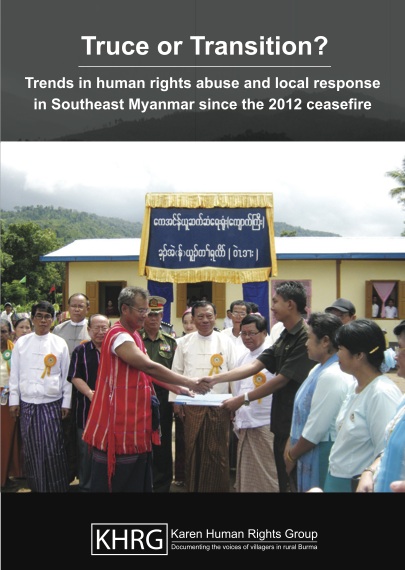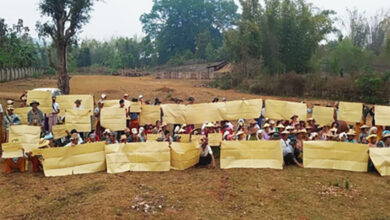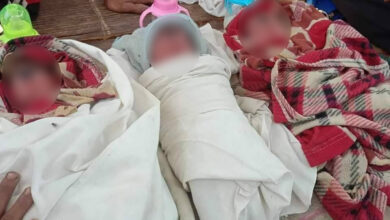Karen Human Rights Groups Report That ‘Peace’ in South-East Burma Brings Its Own Dilemmas

The signing of a January 2012 preliminary ceasefire between Burma’s government and the Karen National Union has brought its own challenges with “new forms of abuse and local concerns emerging in the evolving security environment,” a report released by Karen Human Rights Group has found.
The report, released yesterday, documents the conditions of human rights in South Eastern Burma over the last two years, noted that certain human rights abuses, including forced labour, had sharply declined and that ease of travel had increased.
“KHRG researchers and villagers throughout the seven Karen districts in Southeast Myanmar have described the ability to travel and work more freely as the single most positive trend resulting from the ceasefire,” KHRG said in the report, adding, “This change is due to an end to armed conflict and the accompanying decrease in movement restrictions and harassment by Tatmadaw troops.”
The report also documented that in some areas there was little change due to antipersonnel mine contamination, arbitrary curfews, and arbitrary taxation, by Burma Army and ethnic armed forces.
In an email interview with Karen News, Saw Albert Moo, KHRG’s Field Director, stated that in spite of the cessation in conflict, the lives of many villages had not improved significantly. “The life of villagers that has been impacted by the conflict in staying the same as it was in the past. Their livelihood options, their living conditions, ongoing militarisation (living under heavy army camp activity and soldiers) is still very difficult. Some villagers who been displaced for a long time, still cannot return to their villages,” Saw Albert said.
Drug Trade On the Rise
The KHRG reported pointed out that the ceasefire has been a boon for the methamphetamines trade, which involves government forces – including the Border Guard Force – leading to sexual violence and drug related killings.
“Villagers reported an increase in the production and sale of methamphetamines by BGF soldiers in Hpapun and Hpa-an districts, and have increasingly complained of the negative consequences of drug production, sale and use, as well as related killings and sexual violence, and the negative impacts of its availability on youth and social cohesion,” KHRG said in its report, maintaining that ease of travel since the ceasefire was a factor in the growing drug trade.
New Burma Army Bases
In its report KHRG expressed concern regarding the construction of new Burma Army bases in ethnic areas and the renovation and reinforcement of old bases.
“New Tatmadaw (Burma Army) bases have been built and existing bases have been strengthened in KHRG’s research areas throughout 2012 and 2013. Ongoing militarisation has led communities of internally displaced people to remain in temporary settlements, unwilling to return to their former villages until Tatmadaw camps have been closed.”
General Ner Dah Mya, head of the Karen National Defence Organisation (KNDO), in a January interview with Karen News estimated that the Burma Army now had 300 military outposts in Karen “administered areas.”
A KHRG field researcher said that some villagers felt the ceasefire was an excuse for government forces to reinforce positions in ethnic areas.
“Villagers believe that the ceasefire is not a stable process for them because the Burmese army is rebuilding their camps and sending more rations during the ceasefire,” the field researcher said, adding, “They [villagers] always have to worry and also have to deal with land confiscation and extortion by the Burmese army after the ceasefire. Instead of removing their camps, the army has returned and rebuilt their camps in the mountains, close to the working areas of the villagers, who do not show themselves to the army.”
Land Confiscation Destroying Villagers Lives
Villagers continued to report land confiscation for large-scale development projects or army camps since the ceasefire. The KHRG report documented that land confiscated by the Burma Army had not been returned while the Government used laws classifying villagers’ land as uncultivated or state-owned without the consultation of locals, often uprooting their lives.
“Since the ceasefire, villagers have begun to report increasingly about land confiscation for mining, logging, dams, infrastructure development and commercial agriculture. Land is confiscated by armed actors or the Myanmar government in collaboration with companies for those projects.” KHRG said.
KHRG cited Hatgyi Dam as one example of development projects inciting conflict, “armed conflict broke out between BGF and DKBA soldiers over Hatgyi Dam in 2012, which caused villagers to flee and be displaced from their homes for a short period of time,” KHRG said by email to Karen News, “Because of land confiscation, tens of thousands of villagers have been displaced [Including Toh Boh Dam in Toungoo District] and communities face increasing water contamination and damage to land because of development projects.”
Human rights organisations have reported that the pattern of land confiscation is also present in other parts of Burma, including Shan State, where a government backed company – Asia World Company – which was the target of U.S. sanctions in 2008 because of alleged links to the narcotic drug trade, is building the country’s first dam to straddle the Salween River. The dam, near the town of Kunlong, has led to the displacement of more than 20,000 civilians from 60 villages, Shan Human Rights Foundation confirmed in an previous interview with Karen News.
“The project lacks transparency, violates local people’s rights, and is taking place in an area of active conflict. By going ahead with this massive project before a political settlement has been reached with the ethnic groups about control over natural resources, the Burmese government also risks derailing the peace process,” SHRF said at the time.




